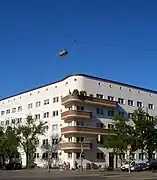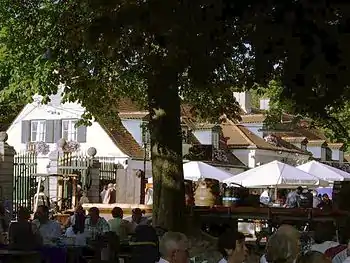Neuhausen-Nymphenburg
Neuhausen (Central Bavarian: Neihausn) and Nymphenburg were boroughs of Munich, the capital of the German state of Bavaria. They were merged into the borough 09 - Neuhausen-Nymphenburg (German: Stadtbezirk 09) in 1992. For further information on the Munich boroughs, see: Boroughs of Munich.
Location

_-_Neuhausen_-_Nymphenburg.png.webp)
Nymphenburg borders Obermenzing in the north-west, Pasing in the south-west, Moosach in the north and Neuhausen in the south-east.
The borough 09 ranges from the Mars-field at the inner edge of town to the Nymphenburg Palace in the west and extends from the south part of the Olympic Park (including the Tollwood Summer festival area and the East-West Peace Church) over the villa colony in Gern to the railway tracks.
History and description
Neuhausen is a very quiet and calm residential area. It counts as one of the most exclusive and expensive boroughs in Munich.
Typical of the borough is its mix of different urban areas. Around the end of the 19th Century a prestigious residential neighborhood was built in the palace's vicinity, where numerous examples of late nineteenth century architecture, like the villa colonies Neuwittelsbach and Gern can be found.
In 1890 the borough Neuhausen was unincorporated, which had already been a prosperous district. It was dominated by residential and office houses in a closed, dense block-building style. Along the Arnulfroad and its side streets, these are often cooperative apartment buildings such as the partly under preservation attempt-settlement of the Bavarian Post and Telegraph Association and the village of Neuhausen. In the north of the Rotkreuzplatz there are more villas and town houses of the early days.
In the south along the railway tracks there are partly dominating large-scale commercial used buildings. Center and urban hub of the neighborhood of the Rotkreuzplatz. Some well-preserved buildings from the founder and inter-war period with the rich variety of green spaces give Neuhausen a high quality of living. While the old quarters in the vicinity of Nymphenburgerstreet and Blutenburgstreet are home to upper middle class for some time, the sometimes less sumptuously executed turn of the century buildings offer in the vicinity of Schulstreet and Donnersbergerstreet housing for various population groups. But has also kept the so-called gentrification catchment by road trains and remodeled buildings were renovated. In addition, there were numerous conversions take place in condominiums and shops were once easy to architectural firms, alternative shops, bars and restaurants. For this reason, the City Council in 2006 extended the statute for preservation of this neighborhood, to counteract the displacement of ancestral inhabitants.
On 1 January 1891 the independent municipality Nymphenburg was incorporated to the city of Munich.
It is named after the Nymphenburg Palace, former summer residence of the Bavarian kings. Today the castle along with the Nymphenburg Palace Park is one of the most popular sights of Munich.
The in 1747 by Elector Max III. Joseph founded Nymphenburg Porcelain Manufactory, the Royal Stables Museum of Nymphenburg and the Museum of Man and Nature is located next to the palace. On the Nymphenburg Palace Park also borders the Botanical Garden, which entrance is near the Bavarian State Office of Weights and Measures. The Hirschgarten and the Olympic Park complement the diverse range of parks and recreational areas. Because the borough is connected by the motorway A8 and the ring road it is charged by high traffic volumes. Neuhausen-Nymphenburg has about 90,000 inhabitants, according to Ramersdorf-Perlach the second highest population of the boroughs of Munich. In the north of Neuhausen, between the borough is Gern and Moosach-Nederling, in the northeastern the borough of Ebenau.
The jobs of the district are in addition to trade and service sector largely in the public sector. Apart from the branch of Deutsche Bahn, the Bundeswehr's administrative center, the Bavarian State Criminal Police Office, and numerous hospitals, such as the Red Cross Hospital, the German Heart Center, the Brothers of Mercy Hospital and the Third Order Hospital there are also major social institutions in the borough.
The proportion of foreigners Nymphenburg is low, in Neuhausen it is average. Regarding the age distribution Neuhausen is the younger of the two districts.
Gallery
- Neuhausen-Nymphenburg
 Red Cross Hospital at Rotkreuzplatz
Red Cross Hospital at Rotkreuzplatz Neuhausen
Neuhausen St. Laurentius (Gern)
St. Laurentius (Gern) Nymphenburg in the winter
Nymphenburg in the winter Hubertusbrunnen in Neuhausen-Nymphenburg
Hubertusbrunnen in Neuhausen-Nymphenburg Third Order Hospital
Third Order Hospital.JPG.webp) Fountain at Rotkreuzplatz in Neuhausen
Fountain at Rotkreuzplatz in Neuhausen Hirschgarten
Hirschgarten Botanical Garden
Botanical Garden![Herz-Jesu-Kirche, Munich [de]](../I/Herz-Jesu-Kirche_Munich_September_2014_02.JPG.webp) Herz-Jesu-Kirche, Munich
Herz-Jesu-Kirche, Munich
Statistics
(As of each 31 December, residents whose main residence)
| year | residents | foreigners | area (ha) | res./ha | source and further details |
|---|---|---|---|---|---|
| 2000 | 81.968 | 17.923 (21,9%) | 1,291,86 | 63 | Statistisches Taschenbuch München 2001. pdf-Download |
| 2001 | 82.235 | 17.972 (21,9%) | 1.291,86 | 64 | Statistisches Taschenbuch München 2002. pdf-Download |
| 2002 | 81.947 | 17.795 (21,7%) | 1.291,86 | 63 | Statistisches Taschenbuch München 2003. pdf-Download |
| 2003 | 81.661 | 17.703 (21,7%) | 1.291,84 | 63 | Statistisches Taschenbuch München 2004. pdf-Download |
| 2004 | 81.921 | 18.041 (22,0%) | 1.291,61 | 64 | Statistisches Taschenbuch München 2005. pdf-Download |
| 2005 | 82.156 | 17.890 (21,8%) | 1.291,45 | 64 | Statistisches Taschenbuch München 2006. pdf-Download |
| 2006 | 84.604 | 18.016 (21,3%) | 1.289,08 | 66 | Statistisches Taschenbuch München 2007. pdf-Download |
| 2007 | 85.964 | 18.118 (21,1%) | 1.287,95 | 67 | Statistisches Taschenbuch München 2008. pdf-Download |
| 2008 | 87.043 | 18.836 (21,2%) | 1.293,31 | 67 | Statistisches Taschenbuch München 2009. pdf-Download |
Education and culture

- Blutenburg-Theatre, Blutenburgstraße 35
- History Workshop Neuhausen e. V., Neuhauser Trafo, Nymphenburger Str. 171a
- Maxim (Cinema), Landshuter Allee 33
- Munich College, Außenstelle Neuhausen, Neuhauser Trafo, Nymphenburger Str. 171a
- Munich Library, Borough-Library, Neuhauser Trafo, Nymphenburger Str. 171a
- Nymphenburger Schools, School-Center, Sadelerstraße 10
- Pathos Transportation Theatre, Dachauer Straße 110d
- Summer Tollwood Festival
Politics
In Munich each borough has a Borough Committee (Bezirksausschuss BA). The Borough Committees are elected by local citizens in municipal elections. The Borough Committee consists 39 members. The election of the Borough Committee of 2 March 2008 yielded the following results:
- SPD 16 seats – 41,4%
- CSU 10 seats – 26,6%
- Bündnis 90/Die Grünen 9 seats – 20,1%
- FDP 3 seats – 7,6%
- David contra Goliath/ÖDP 2 seats – 4,3%
Chairman of the BA is Ingeborg Staudenmeyer (SPD). The Vice-Chairmen are Roland Zintl (Greens) and Immoi Scheibel (CSU). The Greens and the ÖDP provide a common fraction.
The municipality is represented in the City Council by Oliver Belik (SPD) and Councilwoman Elizabeth Schmucker (CSU). [1]
Celebrities
According to legend, Neuhausen was christianised by Blessed Winthir in the 8th century.
- Author Alfred Andersch
- Author Manfred Bieler
- Historian Karl Bosl
- Architect Hans Döllgast
- Toolmaker Anton Drexler[2]
- Actor Helmut Fischer
- Landscape painter Max Haushofer (1811–1866)
- Ellis Kaut, developer of Pumuckl
- Oskar von Miller, founder of Deutschen Museums
- Sculptor Karl Knappe
- Soccer-player Philipp Lahm (born 1983)
- Composer Carl Orff (1895–1982)
- Journalist Ponkie
- Lilo Ramdohr (born 1913), who lived as Lilo Berndl from 1941 until 1944 in Nymphenburg, where in May 1942 cartoons with leaflets of the White Rose had been highjacked by Alexander Schmorell[3]
- Poet Eugen Roth
- Author Augustin Souchy
- Operatic baritone and voice teacher Hermann Wiedemann (1879–1944)
References
- muenchen.de - Bezirksausschusswahl 2008, 17. Dezember 2010
- "Muenchen.de - Nazionalsozialismus". Archived from the original on April 20, 2008. Retrieved October 16, 2011.
- Lilo Fürst-Ramdohr: Freundschaften in der Weißen Rose. Verlag Geschichtswerkstatt Neuhausen, München 1995. ISBN 3-931231-00-3. S.79
External links
- Neuhausen at muenchen.de
- Nymphenburg at muenchen.de
- Bezirksausschuss 9 Neuhausen-Nymphenburg
- Geschichte des Stadtteils
- KulturGeschichtsPfad Neuhausen-Nymphenburg
- Literatur zu Neuhausen-Nymphenburg

